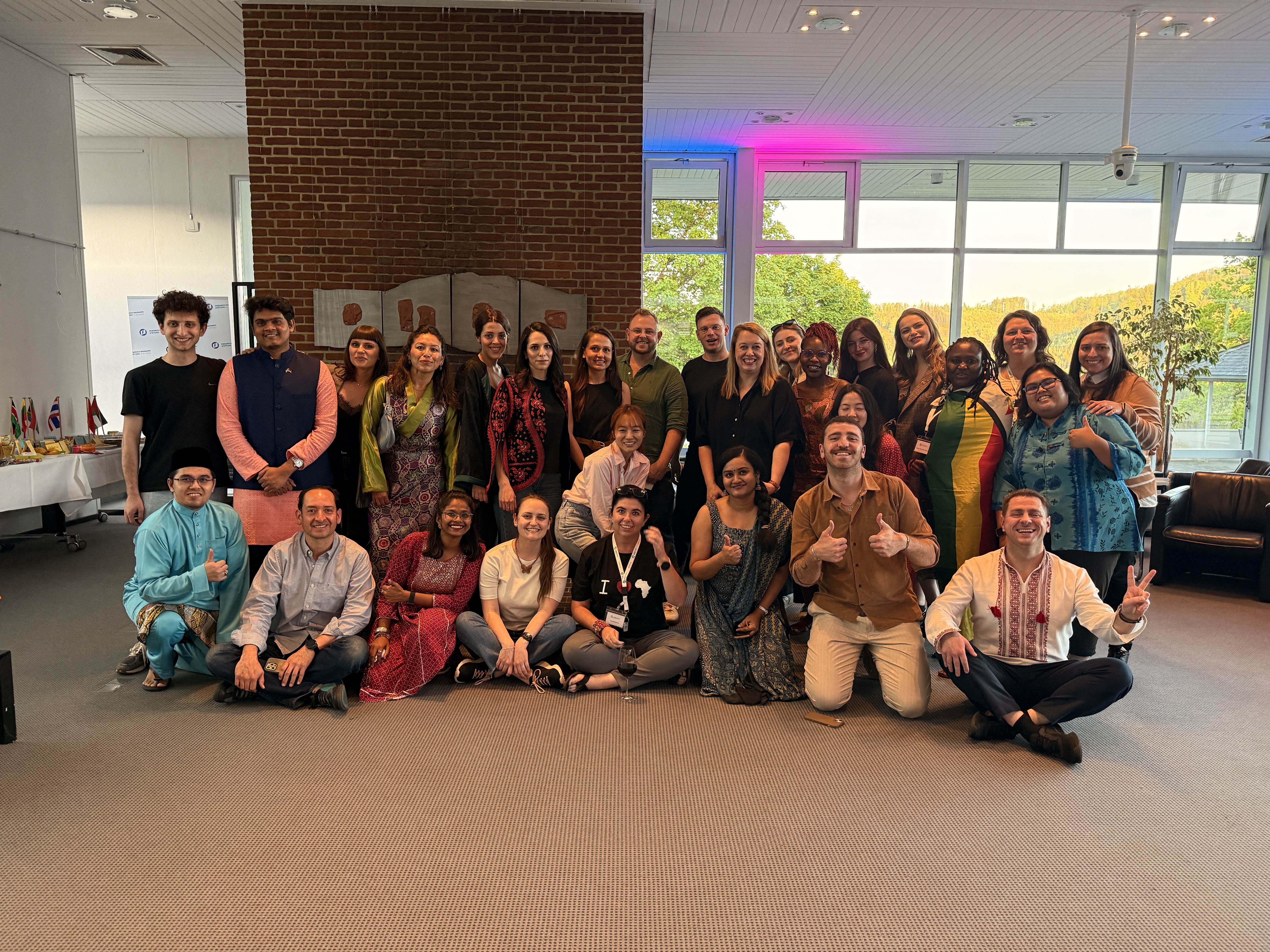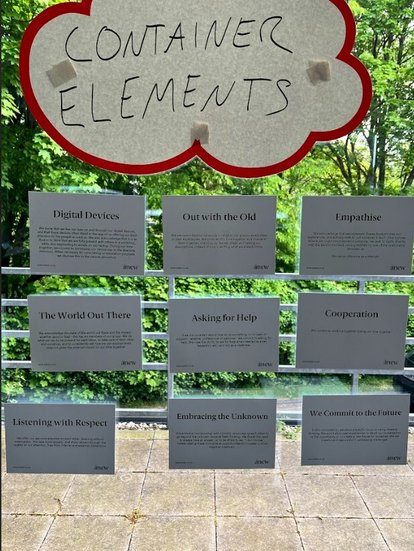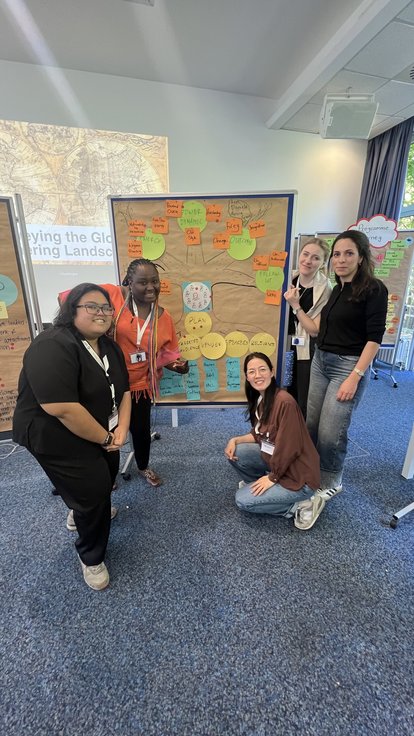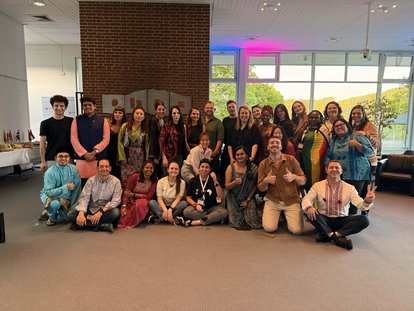International Academy for Leadership
Beyond Facilitation: Holding Space for Connection and Co-Creation

To create a safe space is to allow yourself to acknowledge what you mostly need. That’s the foundation I carried with me throughout my time participating in the IAF Seminar: Moderation and Facilitation—and it’s exactly what our superb facilitators (or as I like to call them, the “facilitation fairies” for their magical touch) did. For 12 days, we were consistently given space to learn about ourselves and how we each have a unique way of connecting with others. In an intense yet soul-fulfilling schedule of activities, Marike Groenewald and Clinton du Preez from Anew, guided us through the science and art behind effective facilitation.
The journey started right off the bat with a scavenger hunt on day one. Imagine 28 strangers from across the globe, split into five groups, running around the vast grounds of the Theodor-Heuss Academy in Gummersbach. We had to complete various missions while introducing ourselves, learning about each other’s backgrounds, and unfold the first layer of unfamiliarity. It was a clever and highly effective ice-breaker. By the next morning, the energy in the room had shifted—people were more comfortable, more open, and more curious about what was coming next.
Before diving into the seminar's core content, Marike and Clinton asked us to collaboratively choose values we wanted to uphold in our shared space. This was about setting our “container”—a sacred atmosphere for learning and collaboration. We chose values such as Listening with Respect, Cooperation, Empathy, Trust, and Embracing the Unknown. These weren't just pretty words; they became living agreements that shaped how we interacted, learned, and supported each other.

One of the first exercises we tackled together was mapping out the global landscape of gatherings and events. To our surprise (or maybe not), we realized that most gatherings tend to follow rigid formats—seminars, panels, lectures. These structures, while familiar, often fail to create anything new. Instead, they tend to focus on talking at people rather than with them. Clinton explained how this lack of engagement actually triggers a stress response in our brains, causing us to retain less information. In contrast, a gathering based on connection, emotion, and presence opens up possibilities for real learning and collaboration. That insight alone reframed how I’ll approach any future program design.
The first week was packed with hands-on group work, giving us opportunities to practice facilitating different formats using the theoretical tools Marike and Clinton had shared. One seminar that stood out was about the eight types of facilitators. It helped me reflect on my own facilitation style. I found myself identifying most with a mix of the Captain and the Organizer—someone who likes to plan meticulously, tends to stay behind the scenes, and sets high standards, sometimes to the point of rigidity. Recognizing this was important. Facilitation isn’t a one-size-fits-all craft; it’s deeply personal. Knowing our own tendencies helps us avoid falling into patterns that don’t serve the group or the process.

The midst of the first week also brought a welcome change of pace with a day trip to Cologne. After days of introspective and interactive work, the excursion felt like a breath of fresh air—both literally and figuratively. We wandered through the historic city, marvelling at the towering Cologne Cathedral, chatting about everything from facilitation philosophies to our favourite street foods back home. It was unstructured time, but deeply nourishing.
The following day, we had an incredibly insightful session that deepened our understanding of the program design process. Clinton led an afternoon workshop titled “The Four Quadrants of Gathering Design,” where we examined how much time we typically spend—or fail to spend—in each phase that contributes to a successful gathering. I realized that I naturally dedicate a lot of time to the first quadrant, Understanding Your Gathering, during the planning stages. This is the phase where the foundational thinking happens—before diving into logistics and structure, it’s about asking the simple but profound question: Why are we gathering? The answer to that question becomes the backbone of the entire experience.
Admittedly, the fourth quadrant, Completing the Cycle, is the one I’ve given the least attention to. Once an event ends, I often shift gears quickly and move on to the next task, unintentionally skipping the essential step of closure and integration. That also means missing out on valuable reflection, feedback, and evaluation—elements that are crucial for learning and growth. This session made me realize just how much value I’ve left on the table by not fully completing the cycle. A thoughtful closing isn’t just a nice-to-have; it’s an act of care that helps participants process, internalize, and carry forward the experience.

Together, these four quadrants formed a holistic map for gathering with purpose and impact. They offered more than a method—they offered a mindset. This is more than just a checklist but rather a framework that help us to integrate our thought, plan, and intention in creating a gathering. As someone who loves to plan but often forgets to pause, reflect, and integrate, this framework was an anchor. It gave structure to the abstract, and offered language for what many of us feel intuitively but don’t always know how to articulate.
Then came Culture Night.
Honestly, it was one of the most heart-warming and memorable parts of the seminar—along with the spontaneous Pub Quiz that we all kept playfully pushing for until it finally happened. We brought our own vibrant songs, dances, and colours that inherent with our own culture and tradition. What made it special wasn’t just the diversity, but the way we embraced each other’s cultures with genuine curiosity and appreciation. It was a celebration of culture and heritage, where we shared joy and our differences felt like bridges that connect us all.

By the weekend we travelled our way to the historical city of Heidelberg for a change of scenery, along trip we also had a chance to meet guest facilitators with new topics. One of which was the art of visualization. We learned how powerful it can be to use simple visuals, metaphors, and drawings to enhance understanding and engagement in group settings. You don’t have to be an artist; it’s not about the skill but your willingness to open your own self-restrict in trying to draw. A stick figure with a story is worth a thousand words. It reminded me that facilitation isn’t just about speaking; it’s also about showing.
Another session that I found enjoyable was the “Enabling Ease in the Nervous System: Working with the Body and Breath.” Led by a guest facilitator, Jennifer Miksch, it was a beautiful shift from the cognitive-heavy sessions we were used to. We were invited to take notice of our breath, inhale and exhale on our own pace, trying to tune in to our body that often held too much tension. As facilitators, we often focus so much on the flow of the session that we forget our presence is our biggest tool. When we ground ourselves, we help others feel grounded too. Learning to work with my nervous system, not against it, was a game changer.
As the seminar draws to an end, we were introduced to Open Space Technology—a facilitation method that perfectly encapsulates the spirit of self-organization and collective creation. In Open Space, the agenda is created by the participants themselves, guided by the principles that “whoever comes is the right people, when it is over it is over, whenever it starts is the right time, and whatever happens is the only thing that could have.” It was intriguing to learn about such concept, also very daring to have such an unstructured, participant-led session. People proposed sessions on topics they were passionate about or have questions about it—ranging from dealing with highly traumatized groups, adapting facilitation techniques for people with special needs and/or disabilities, also to use journaling as one of the facilitation technique. The energy was invigorating. We saw leadership emerge organically, with people stepping up not because they had to, but because they wanted to contribute.
By the last day, there was a palpable sense of community. It was as if we’ve known each other for years, reunited for a whimsical time, and flew back again to all over the worlds. We were part of an experience that had shifted something fundamental in each of us. The closing circle was quite emotional yet powerful. We each shared reflections, insights, and gratitude, all of which become our shared power that each of us bring back to our home country. There were tears, laughter, and a deep sense of connection.
The entirety of this seminar wasn’t just about facilitation techniques or program design. It was about giving a touch of humanity in how we gather, speak, listen, and show up—for ourselves and for others. It was a reminder that creating a space isn’t about having all the right tools or saying the perfect words. It’s about being present, intentional, and kind. Trusting others—both in the process and in the people in the room.
I came to Gummersbach to learn about facilitation. I left with something far more valuable: a deeper understanding of how to hold space safely, not just for others, but also for myself.
And that is where the magic happened.
